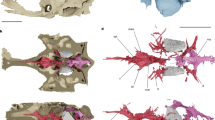Abstract
THE panderichthyids (or elpistostegids) are the most tetrapod-like fishes that still retain paired fins rather than limbs. During the transition from fish to tetrapod, the braincase, previously subdivided by a joint, was remodelled into a solid structure4. Here we present the complete braincase of the fish Panderichthys rhombolepis, a Middle Devonian1 member of the tetrapod stemgroup2,3. Panderichthys has an externally tetrapod-like skull2, but we show that the braincase retained the intracranial joint, conforming wholly to the generalized pattern of lobe-finned fish, and sharing no obvious derived features with tetrapods. This places the braincase transformation between Panderichthys and the earliest tetrapods exemplified by Acanthostega4. The timing of the braincase transformation closely matches that of the limbs. There are also striking similarities with the braincase transformation in the lungfish lineage. Both phenomena may reflect developmental linkages and canalization.
This is a preview of subscription content, access via your institution
Access options
Subscribe to this journal
Receive 51 print issues and online access
$199.00 per year
only $3.90 per issue
Buy this article
- Purchase on Springer Link
- Instant access to full article PDF
Prices may be subject to local taxes which are calculated during checkout
Similar content being viewed by others
References
Mark-Kurik, E. in Abstracts of the Second Baltic Stratigraphic Conference (eds Grigelis, A., Jankauskas, T.-R. & Mertiniene, R.) 57 (Baltic Stratigraphic Association, Vilnius, 1993).
Vorobyeva, E. I. & Schultze, H.-P. in Origins of the Higher Groups of Tetrapods: Controversy and Consensus (eds Schultze, H.-P. & Trueb, L.) 68–109 (Comstock, Ithaca, NY, 1991).
Ahlberg, P. E. & Milner, A. R. Nature 368, 507–514 (1994).
Clack, J. A. Nature 369, 392–394 (1994).
Jarvik, E. Basic Structure and Evolution of Vertebrates Vol. 1 (Academic, London, 1981).
Millot, J. & Anthony, J. Anatomie de Latimeria chalumnae. Tome L. Squelette, muscles et formations de soutien (CNRS, Paris 1958).
Clack, J. A. Nature 342, 425–430 (1989).
Ahlberg, P. E. Nature 373, 420–425 (1995).
Ahlberg, P. E., Lukševičs, E. & Lebedev, O. Phil Trans. R. Soc., Lond. B 343, 303–328 (1994).
Clack, J. A. ZooL. J. Linn. Soc. (in the press).
Lebedev, O. A. & Coates, M. I. Zool, J. Linn. Soc. 114, 307–348 (1995).
Vorobyeva, E. I. & Kuznetsov, A. in Fossil Fishes as Living Animals (ed. Mark-Kurik, E.) 131–140 (Academy of Sciences of Estonia, Tallinn, 1992).
Coates, M. I. & Clack, J. A. Nature 347, 66–69 (1990).
Coates, M. I. & Clack, J. A. Bull. Mus. natn. Hist, nat. Paris 17, 373–388 (1995).
Ahlberg, P. E. Nature 354, 298–301 (1991).
Thomson, K. S. Zool. J. Linn. Soc. 46, 223–253 (1967).
Maisey, J. G. Cladistics 2, 201–256 (1986).
Panchen, A. L. & Smithson, T. R. Biol. Rev. 62, 341–438 (1987).
Ahlberg, P. E. Zool. J. Linn. Soc. 103, 241–287 (1991).
Chang, M.-M. & Smith, M. M. J. vert. Paleontol. 12, 294–312.
Cloutier, R. & Ahlberg, P. E. Géobios Mém. Spéc. 19, 241–248 (1995).
Chang, M.-M. The Braincase of Youngolepis, a Lower Devonian Crossopterygian from Yunnan, South-Western China thesis, Univ. Stockholm, 1982.
Gardiner, B. G. Bull. Br. Mus. nat. Hist. 37, 173–428 (1984).
Ahlberg, P. E. J. Morph. 220, 319 (1994).
Moy-Thomas, J. A. & Miles, R. S. Palaeozoic Fishes 2nd edn (Chapman & Hall, London, 1971).
De Beer, G. R. Development of the Vertebrate Skull (Oxford Univ. Press, 1937).
Vorobyeva, E. The problem of the Terrestrial Vertebrate Origin (Nauka, Moscow, 1992).
Worobjewa, E. J. Palaeontographica A 143, 221–229 (1973).
Vorobyeva, E. I. & Tsessarsky, A. A. J. gen. Biol. 47, 735–747 (1986) (in Russian).
Jarvik, E. Meddr. Grønland 187(2), 1–307 (1972).
Author information
Authors and Affiliations
Rights and permissions
About this article
Cite this article
Ahlberg, P., Clack, J. & Luks̆evic̆s, E. Rapid braincase evolution between Panderichthys and the earliest tetrapods. Nature 381, 61–64 (1996). https://doi.org/10.1038/381061a0
Received:
Accepted:
Issue Date:
DOI: https://doi.org/10.1038/381061a0
This article is cited by
-
Morphology of Palaeospondylus shows affinity to tetrapod ancestors
Nature (2022)
-
Neurocranial development of the coelacanth and the evolution of the sarcopterygian head
Nature (2019)
-
Morphology of the earliest reconstructable tetrapod Parmastega aelidae
Nature (2019)
-
A reevaluation of the anatomy of the jaw-closing system in the extant coelacanth Latimeria chalumnae
Naturwissenschaften (2013)
-
Ventastega curonica and the origin of tetrapod morphology
Nature (2008)
Comments
By submitting a comment you agree to abide by our Terms and Community Guidelines. If you find something abusive or that does not comply with our terms or guidelines please flag it as inappropriate.



